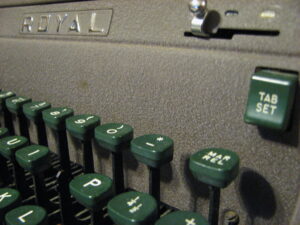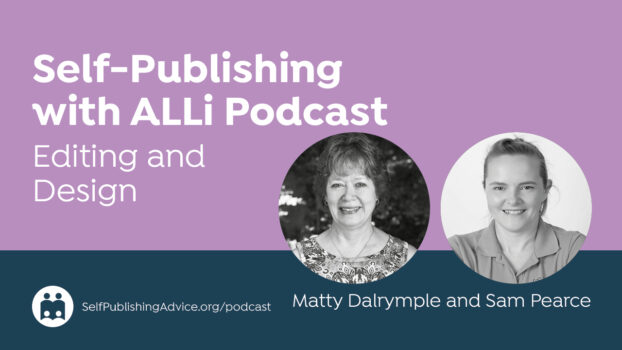 If you want to make your self-published books as professional as possible, it's important to pay attention to formatting details such as margins and spacing. Today we're looking at an issue too easily overlooked and often misunderstood, perhaps because it's invisible: the blank space after a period.
If you want to make your self-published books as professional as possible, it's important to pay attention to formatting details such as margins and spacing. Today we're looking at an issue too easily overlooked and often misunderstood, perhaps because it's invisible: the blank space after a period.
Just how big should that space be? One space, two spaces, more?
This was the question posed by one of our authors on our members-only forum recently. Other questions swiftly followed:
- Isn't this down to the preference of the individual?
- Can there truly be any rights and wrongs?
- As indie authors, surely it's our prerogative to put as many or as few spaces as we like?
Here's the gist of the ensuing conversation…
One Space Versus Two Spaces
When we learn to touch type, it's drummed into us how many spacebar spaces to insert after a period (full stop).
- When learning to type on computer keyboards, the convention is just one.
- For those who learned our keyboard skills on typewriters, the convention was two.
(By the way, if you haven't yet learned how to touch type – it's never too late to learn, and it can vastly improve your writing productivity. More on that score here.)
Why the Difference?
The arrival of digital typesetting changed the way characters are arranged on the line:
- In the pre-computer age, typewriters gave precisely the same amount of space to each letter, regardless of its width.
- With digitally typeset text, letters are proportionally spaced according to their width, optimising the use of space – so an i, for example, will be given less space on the page than a w. This makes more economical use of paper, as well as being easier on the eye of the reader.
If you want to remind yourself what a difference that makes, try formatting a piece of text with the Courier font, which emulates an old-fashioned typewriter. (Remember, typewriters offered only a single font and type size.)
Should We Change?
So if we're used to typing two spaces, should we reprogramme ourselves to one? Does it really matter?
Two spaces afer a period look like this. As opposed to one after this sentence. Not a big difference to the untrained eye, but enough to irritate a purist.
However many spaces you choose to use – and yes, it is your prerogative as an indie if you don't want to comply with convention – we recommend that, just as with spelling and punctuation, you make sure you are consistent, to provide a satisfactory experience for your readers.
Even if you think you have been consistent, it's easy for extra spaces to creep in during the editing process by mistake, so here's how to check.
1 Easy Way to Eliminate Surplus Spaces After Sentences
View your manuscript such that all your formatting marks are shown on the screen. In Word, this means clicking the back-to-front P sign in the top toolbar:

Click the paragraph sign in Word to show all your formatting
Your spacebar spaces will show as dots. The easiest way to check for excess ones is then to type in ” ” (ie spacebar spacebar) into the search box, to highlight each incidence. Then simply delete the surplus spaces/dots.
You might also want to try “(spacebar spacebar spacebar)” or even more multiples to be on the safe side. (Yes, you can do it in a single stroke with a global search and replace action, but it's best to avoid that function as it too often leads to unintended consequences!)
While you're unlikely to get a negative review for an otherwise fabulous read because you've used two or more spaces after each period, it's attention to detail like this that separates the professionals from the amateurs.
How many spaces to type after a period - plus 1 easy way to eliminate excess spaces Share on XOTHER USEFUL POSTS ABOUT FORMATTING – from the ALLi Archive





See, I was never taught to do double spaces after periods. It was when trying to learn to format film scripts where I picked it up. Because film scripts are Courier, it follows the same logic as a typewriter. And it’s hammered HARD in your head that basically if a script isn’t formatted very specifically it won’t be read by studios and such, because studios get a bunch of scripts and why should they care to read a script when the writer didn’t care enough to format it properly.
But since double-spacing after periods I’ve noticed that it helped me read. Essay paragraphs looked like they are made from sentences and not just a block of text you have to power through, more so since I have dyslexia and reading already feels like a chore. The only thing I ever see people who argue against double spaces say is “We don’t need to do that anymore! We aren’t typing on typewriters” but fails to acknowledge that double-spacing either doesn’t hurt anyone or actually helps some read. But who needs to think about that, when “Double space bad.”
And I noticed that a lot of social media sites like Tiktok and apparently this website (or whoever hosts the website or whatever) remove double spaces, even when typed in. It really makes it hard to try to read replies. It’s the visual equivalent to someone just talking with no stops.
It is in point of fact a nice and helpful piece of information.
I’m happy that you simply shared this useful information with us.
Please keep us informed like this. Thanks for sharing.
Hmm, interesting. As a reader, I find too little space cramped, but too much jarring. Thanks for the advice!
I am afraid I don’t write for purists. I write for folk who read. Lots and lots of folk have sight difficulties of one sort or another, and the double space between sentences is MUCH easier to read. This is true for folk with dyslexia, slow readers, and older folk wth sight problems.
As I am frequently told how clear my books are to read, I will be sticking to 2 spaces, regardless of what purists think! There are fewer purists in my field.
Thanks! I was taught the two spaces way but see the sense of just one.
Another way to get rid of the excess space is to import your Word file to Scrivener then choose:
Format
Convert
multiple spaces to space
I think that what you published was very logical. But, think on this, what if
you added a little information? I ain’t suggesting
your content is not good, but suppose you
added a title that makes people desire more? I mean How Many Spaces
After a Period? | Self-Publishing Advice
Center is kinda vanilla. You ought to glance at Yahoo’s front page and note how they
write article headlines to grab people to open the links.
You might try adding a video or a related pic or two to get readers interested about everything’ve written. Just my opinion, it could bring your blog a little bit more interesting.
I learned to type with the double space and have since learned it’s incorrect in with digital print. There’s a very quick way to fix it in MS Word though: Just put ” ” in the “find what” box and then put ” ” in the “replace with” box.
(Just took out my double spaces manually. Old habits die hard.)